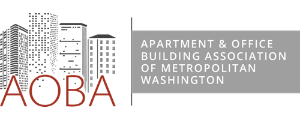At Issue MD - Is the Commercial Office Sector the Next Big Economic Bubble?
Economic forecasts paint a rather bleak picture for the future of the commercial office market; a concern that local and national media has begun to spotlight. The cascading impacts for our region and our nation over the next three to four years could be extremely significant.
The COVID-19 pandemic shut down our workplaces and forced many of us to work remotely. Even as the public health emergency has subsided, it is clear that telework and hybrid work arrangements are here to stay. This is evident in office occupancy rates, which showed initial signs of recovery but have since plateaued well below pre-pandemic levels. Average weekday office occupancies in the Washington metropolitan region have stabilized at under 50%.
The good news is that the commercial office sector didn’t fall off a cliff during the pandemic, attributable to the long-term nature of commercial leases, which typically span 7-10 years. But as tenant leases come up for renewal over the next several years, it is expected that many commercial tenants will be either giving back the keys entirely or significantly reducing their footprints. Office vacancy rates, already high prior to the pandemic, threaten to climb to historically unseen levels.
Compounding matters, the industry is concurrently faced with extreme inflation that has driven up operating costs and interest rates. Higher costs and reduced revenues place downward pressure on property values, a dynamic that will place progressively more owners underwater on their mortgages and unable to secure refinancing as time goes on. This is a prospect that many owners already face.
The implications are myriad. Vacant buildings threaten the viability of our downtowns and commercial corridors, not to mention the stability of the banks that are heavily invested in the financing of commercial office buildings. Reduced property values additionally impact one of our localities’ primary revenue streams – real estate taxes, which directly affect funding for our schools, public safety, parks, libraries, transportation, and environmental initiatives.
It is important that policymakers understand the significant changes facing the commercial real estate sector as they consider future public policy actions. In that vein, AOBA has digested recent and timely news accounts spotlighting the uncertainty within a struggling commercial office market below.
Media Digest
Bisnow
- Office Leasing Slows To Historic Lows In D.C., With Law Firms Providing A Backstop
- Plunging Office Values Expected To Sap $464M From D.C. Tax Revenue
- Office Landlords To U.S. Government: Without Help, We're Heading For A Financial Catastrophe
Bloomberg - A $1.5 Trillion Wall of Debt Is Looming for US Commercial Properties
WBJ - Could more than 1B square feet of US office space become obsolete?
CNN - American offices are half-empty. That could be the next big risk for banks
The Real Deal - CRE debt problem to get worse through 2027
Market Analysis
Trepp - Seeking Office Answers? Look to the Largest Office Tenant…Government

At Issue is compiled by the Apartment and Office Building Association (AOBA) of Metropolitan Washington, and is intended to help inform our elected decision-makers regarding the issues and policies impacting the commercial and multifamily real estate industry.
AOBA is a non-profit trade organization representing the owners and managers of approximately 185 million square feet of office space and over 400,000 apartment units in the Washington metropolitan area. Of that portfolio, approximately 80 million square feet of commercial office space and 94,000 multifamily residential units are located in the District. Also represented by AOBA are over 200 companies that provide products and services to the real estate industry. AOBA is the local federated chapter of the Building Owners and Managers Association (BOMA) International and the National Apartment Association.
AOBA strives to be an informational resource to our public sector partners. We welcome your inquiries and feedback. For more information, please contact our Senior Vice President of Government Affairs, Brian Gordon.
